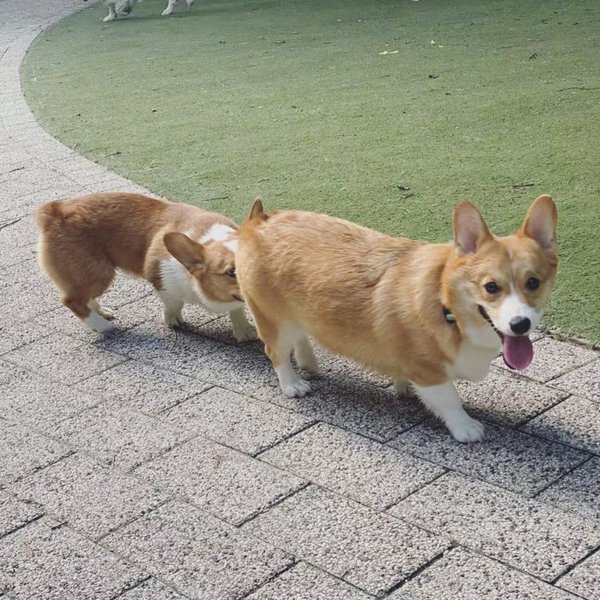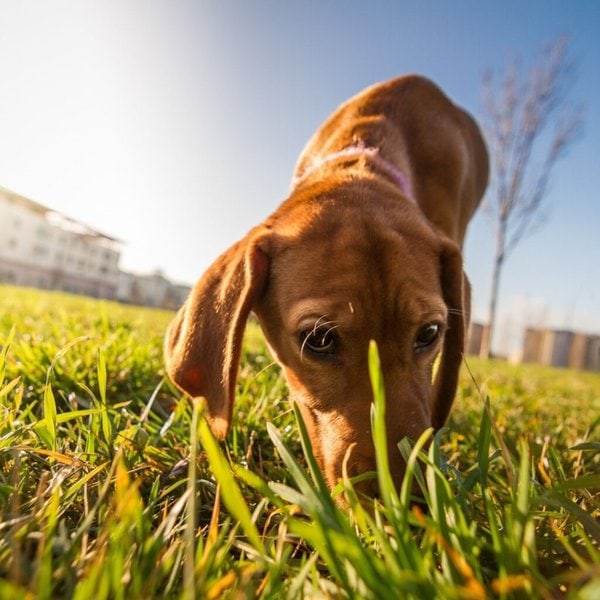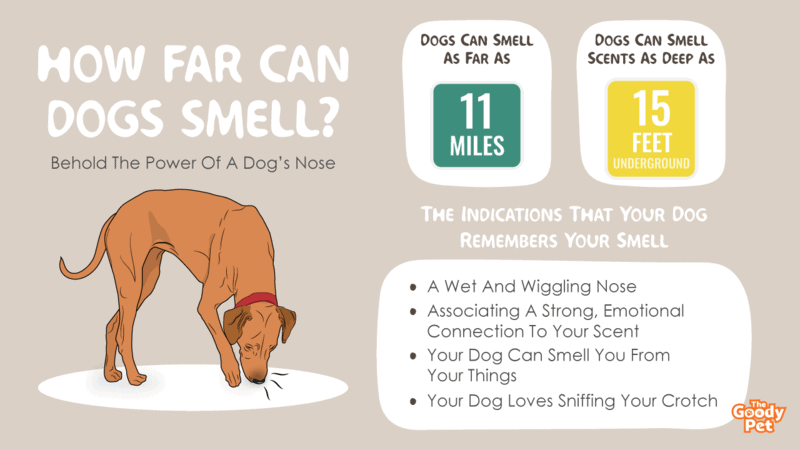Regardless of a dog’s breed, all of them have one thing in common – and that is their magnificent sense of smell. Those cute little noses possess a very keen sense of smell that is more powerful and sophisticated than a man-made instrument. So, what are their noses made up of that we humans do not have in our olfactory system?
Dogs can smell as far as 11 miles away as they have a part of their brain mainly devoted to analyzing smells, and the Jacobson’s organ to boost their smelling capability. Moreover, the nose of a dog has an average of 300 million olfactory receptors compared to the mere 6 million receptors of a human nose.
The aforementioned Jacobson’s organ found in the nose of a dog is considered to be a second olfactory system which is located at the bottom of their nasal passage. This organ is so powerful that male dogs can smell a female dog in heat as far as 15,840 feet away.
Today, we’d be learning more about the power of your dog’s nose. It’s interesting to know if your dog can smell you if you are just around the corner, why dogs are trained to smell drugs, and if their olfactory system is so powerful that they can detect smells through walls.
How Far Away Can Dogs Smell Your Scent?
Dogs can smell your scent 11 miles away! Even if you are that far away from your dog, it can still smell your scent from that incredible distance. Yes, it is mind-boggling to learn that but that is how a man’s best friend’s nose functions.
According to Dr. Bonnie Beaver, Founder of The American College of Veterinary Behaviorists, dogs are very big on scent and will always find their way back home to their owners by using their nose as a navigational tool.
What’s the science behind your dog’s ability to smell your scent from afar? What are the indications that your dog remembers how you smell? Let’s dig deeper into this astounding power of your dog’s olfactory system.

The Science Behind A Dog’s Ability To Smell Its Human Family
Unlike human noses, a dog’s nose has two functions – one for breathing and the other one is for smelling. So when your dog inhales, there’s a fold of tissue inside its nostrils that separates these two functions of the nose. A portion of the air goes to the olfactory sensing area and the other portion is for breathing.
And, each time your dog exhales, the scent remains in the sensory area sustaining the experience of the smell.
Adding to these two functions, remember when we said a while ago how sophisticated a dog’s olfactory receptors are? Bearing this in mind, it is no wonder that your dog can remember your scent even if you are miles away.
The Indications That Your Dog Remembers Your Smell
A wet and wiggling nose should be your first indicator that your dog remembers your scent. Every time you pet, feed, and play with your dog, it uses the power of its nose to smell you and associates your smell with positive vibes.
This, in turn, leads to associating a strong, emotional connection to your scent. That being said, if you see its nose wet and wiggling even without looking at you, your canine companion recognizes you through your scent.
Do you see your dog snuggling up to your bedding or even your socks? That’s because your dog can smell you from your things. Your canine companion is associating its love for you with the things that smell like you.
Do you ever wonder why your dog loves sniffing your crotch? It’s because of your apocrine and sweat glands, which are concentrated in the armpit and genital areas. Smelling your crotch is your dog’s way of welcoming you, apart from the obvious tail wagging.
How Many Miles Away Can A Male Dog Smell A Female Dog In Heat?
A male dog can smell an intact female in heat as far as 3 miles and the reason for this is the Jacobson’s organ or also known by the name of the vomeronasal organ.
Jacobson’s Organ
When a female dog is in heat, she produces pheromones that male dogs can track as far as 3 miles. This is why it is not unusual to see behavioral changes once a male dog smells a female dog’s receptiveness to mating.
Blame it on an olfactory chamber called Jacobson’s organ, which is located in the nasal cavity and opens into the upper portion of a dog’s mouth.
The main function of Jacobson’s organ is to recognize pheromones which provide dogs with the information that a female dog is ready for breeding. A male dog can smell pheromones in the urine as well as other substances that are emitted by a female dog when she is in heat.
In fact, even subtle hormonal changes in a female’s reproductive system cannot escape the strong sense of smell of a male dog. This is because our canine buddies are wired to breed and multiply. Thus, their noses are equipped with sophisticated nasal passages that are able to track the scent of an imminent estrus heat cycle.
You may be asking, how can you stop male dogs from smelling your female dog in heat? The good news is that there are things you can do to mask or cover up the heat smell to prevent unwanted pregnancies.

Ways To Covering Up The Scent Of A Female Dog In Heat
- Chlorophyll supplements can be added to the drinking water of your female dog. Though this method won’t completely eliminate the heat smell, at least, it will be lessened. The usual dosage is one tablespoon in the morning and another one in the evening, to be given on the first day of the heat cycle.
- Have you heard of a lust buster that can be applied to the nose of your male dog to temporarily cover up the heat smell of a female dog? These lust buster products are oftentimes used in dog shows, so the male dogs’ attention will not be distracted by the scent of female dogs in heat.
For as long as love is in the air, it can be pretty challenging to stop male dogs from smelling female dogs due to the nature of their olfactory system. But, at least, you can employ the above safe steps to reduce the heat smell of female dogs.
How Far Can Dogs Smell Drugs?
A trained sniffer dog can smell marijuana seeds as far as 15 feet. Plus, the residual marijuana smell on clothes can still be detected two days after exposure.
Sniffer dogs, also known by the name, narcotic detection dogs, are trained to use their senses, particularly the sense of smell, to detect a variety of drugs.
Actually, sniffer dogs have no interest in illegal drugs per se but what they search for are their favorite toys. The rigid training programs have led them to associate drugs with their toys.
In this section, let us enter the world of drug detection dogs. Let’s talk about issues like training programs, the substances that they can detect, and which dog breeds are excellent at smelling drugs.
The Training Methods Of Narcotic Detection Dogs
The first step in training a puppy is to play a game of fetch using the puppy’s favorite toy. In most cases, the toy is an unscented white towel. Eventually, some drugs are rolled inside the white towel until the dog learns to associate the smell of the drug with that of its toy.
The next step is to hide the toy in different areas of the room. The dog, with its keen sense of smell, will look for the towel. If done successfully, the dog is rewarded with treats.
To move on to the next level, the towel is hidden in areas where it is more difficult to locate, such as inside a container or tucked in a faraway area. Also, narcotic detection dogs are trained to smell drugs at public events, multi-occupancy premises, borders, and boundaries.
In the eyes of these dogs, finding traces of illegal drugs is a game from which they will be rewarded.

Illegal Drugs That Dogs Can Smell
- Marijuana
- Heroin
- Cocaine
- Crystal meth
- Molly or ecstasy
- Bath salts
- Opioids
Narcotic Sniffing Dogs Certification
In order for narcotic detection dogs to be certified by the National Narcotic Detector Dog Association, the dogs should be able to locate marijuana and cocaine in an examination proctored by the agency.
To pass the test, a dog must be able to smell a stash of 10 grams of cocaine hidden in a room of 1,000 square feet or the equivalent of a 2-bedroom apartment.
For marijuana, the dog should be able to smell ¼ ounce per stash in the same size as a room.
Dog Breeds That Are Best For Sniffing Drugs
Not all dogs can sniff drugs. Factors such as agility, stamina, and intense focus are all factored in. The commonly trained dogs are the following:
- Belgian Malinois
- German Shepherd
- German Shorthair Pointer
- Labrador Retriever
- Border Collie
- English Springer Spaniel
How Deep Down Can Dogs Smell?
A dog can smell scents as deep as 15 feet underground and this is the reason why dogs are trained to search for cadavers.
Can dogs smell pests deep down the ground? What about through walls? If yes, what’s the science behind these abilities? We have answers to these interesting questions about the power of a dog’s nose, but first, let’s learn more about cadaver dogs.
Cadaver Dogs
These are dogs that are trained to search for the remains of decomposing human bodies buried 15 feet and more under.
Did you know that cadaver dogs are 95% accurate at smelling cadavers deep down? Not only that, but cadaver dogs can smell the difference between decomposing human bodies and animals.
The same is true when it comes to residual scents. If a body or some body parts were transferred to another location by hard-core criminals, cadaver dogs could still pinpoint the crime scene, providing law enforcers with important information.
It is worth mentioning that not all dog breeds can be trained to smell cadavers. German Shepherds are one of the best police dog breeds for the job because they have a higher number of olfactory receptors, which is about 225 million.

Can Dogs Smell Underground Pests?
Yes, they can! This is because of their heightened sense of smell and hearing. There are many reasons why dogs dig, one of those is when they sense something’s moving underground.
Referred to as termite dogs, these are the ones that are trained to smell methane, a type of scent emitted by termites while digesting wood.
And, when it comes to smelling termites, the Beagles are the best for the job. Not only do Beagles belong to the hound family, but their small bodies allow them to go through tight spaces to locate the termites.
Can Dogs Smell Through Walls?
Yes, dogs can smell through porous walls. This is because dogs have a lot of tiny nose hair, known as cilia, that allows them to smell through walls. However, dogs also have limitations because the material of the wall is a factor that determines the dogs’ abilities.
If the wall is made from a porous plasterboard, then, yes, dogs will be able to smell through it. Plasterboards have microscopic holes that allow the scent to escape making it possible for dogs to smell through them.
But, if the wall is non-porous, such as glass or metal, then no, dogs can’t smell through non-porous walls.





